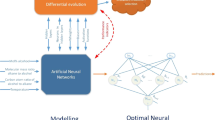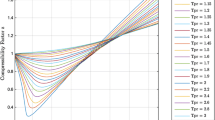Abstract
The extended corresponding states (ECS) model has been extensively studied for representing the thermodynamic surface of pure fluids and mixtures in the a R(ρ, T) form, and the most advanced version is currently the one for hydrofluorocarbons, but the shape factors ϑ(ρ, T) and ϕ(ρ, T) have yet to be determined as analytical functions for the whole PρT surface of a pure fluid. For a sample of pure halocarbons, this work aims to solve the fundamental problem of determining the individual shape functions over the entire PρT domain through an innovative predictive procedure using a density model requiring only a single saturated liquid density input. An original algorithm using artificial neural networks enables the determination of the ϑ(ρ, T) and ϕ(ρ, T) functions from a priori knowledge of their functional forms. The proposed algorithm focuses on the determination of the residual Helmholtz energy a R(ρ, T) for each fluid, subsequently allowing any other thermodynamic residual function to be calculated through the first and second derivatives of temperature and density. For each fluid studied, the model has been validated for residual functions against the same functions coming from highly accurate dedicated equations of state. The prediction accuracies reach average absolute deviation values ranging from 0.3 to 7.8%, spanning from vapor and liquid regions to supercritical conditions, while the corresponding results of the conventional ECS method range from 0.54 to 20%.
Similar content being viewed by others
REFERENCES
T. M. Reed and K. E. Gubbins, Applied Statistical Mechanics (McGraw-Hill, New York, 1973).
J. S. Rowlinson and F. L. Swinton, Liquids and Liquid Mixtures (Butterworths, Oxford, 1982).
M. Huber and J. F. Ely, Int. J. Refrig. 17:18 (1994).
J. S. Rowlinson and I. D. Watson, Chem. Eng. Sci. 24:1565 (1969).
J. F. Ely, Adv. Cryog. Eng. 35:1511 (1990).
R. Schmidt and W. Wagner, Fluid Phase Equil. 19:175 (1985).
F. Rosenblatt, Psychol. Rev. 65:386 (1958).
J. L. McClelland and D. Rumelhart, Explorations in Parallel Distributed Processing, 2 vols. (MIT Press, Cambridge, MA, 1988).
A. Normandin, B. Grandjean, and J. Thibault, Ind. Eng. Chem. Res. 32:970 (1993).
C. Lombardi and A. Mazzola, Ann. Nucl. Energy 24:1373 (1997).
R. Kühne, R. U. Ebert, and G. Schüürmann, Chemosphere 34:671 (1997).
R. Sharma, D. Singhal, R. Ghosh and A. Dwivedi, Comput. Chem. Eng. 23:385 (1999).
J. Homer, S. C. Generalis, and J. H. Robson, Phys. Chem. Chem. Phys. 1:4075 (1999).
V. Kurkova, Neural Networks 5:501 (1992).
R. T. Jacobsen, S. G. Penoncello, and E. W. Lemmon, Fluid Phase Equil. 80:45 (1992).
S. G. Penoncello, R. T. Jacobsen, and E. W. Lemmon, Fluid Phase Equil. 80:57 (1992).
A. Kamei, S. W. Beyerlein, and E. W. Lemmon, Fluid Phase Equil. 80:71 (1992).
S. L. Outcalt and M. O. McLinden, Int. J. Thermophys. 16:79 (1995).
S. G. Penoncello, R. T. J acobsen, K. M. de Reuck, A. E. Elhassan, R. C. Williams, and E. W. Lemmon, Int. J. Thermophys. 16:781 (1995).
R. Tillner-Roth and H. D. Baehr, J. Phys. Chem. Ref. Data 23:657 (1994).
R. Tillner-Roth, Int. J Thermophys. 16:91 (1995).
R. Fletcher, Practical Methods of Optimization, 2nd ed. (Wiley, Chichester, UK, 1987).
M. Grigiante, G. Scalabrin, and S. Bobbo, Proc. 20th Int. Congr. Refrig., Sydney, Australia (1999).
G. Cristofoli, M. Grigiante, and G. Scalabrin, Fluid Phase Equil. 170:23 (2000).
G. Scalabrin, M. Grigiante, G. Cristofoli, and L. Piazza, Int. J. Refrig., submitted for publication.
Author information
Authors and Affiliations
Rights and permissions
About this article
Cite this article
Scalabrin, G., Piazza, L. & Cristofoli, G. Application of Neural Networks to a Predictive Extended Corresponding States Model for Pure Halocarbon Thermodynamics. International Journal of Thermophysics 23, 57–75 (2002). https://doi.org/10.1023/A:1013992608159
Issue Date:
DOI: https://doi.org/10.1023/A:1013992608159




